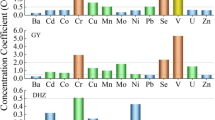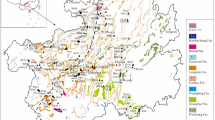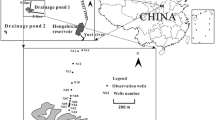Abstract
Water–coal interactions are dominant factors that affect water quality in coal mines. Using lixiviation, the effects of water–coal interactions on pH, salinity, and hazardous elemental enrichment in coal mine water and associated trends were simulated and analyzed. The salinity and hazardous element contents were low in the alkaline solution filtrate. However, the salinity and contents of hazardous elements (As, Cr, Zn, Cu, Mn, Co, Ni, Cd, Pb, U, and Be) in acid solution filtrate increased significantly with a decrease in pH. The pH of the solution filtrate was affected by the mineral composition of the coal, wherein the pyrite content could generally determine the pH. In addition, the spatial distribution and utilization potential of coal mine water quality in China was determined based on water quality data surveys. For water-deficient regions in northern China, particularly in the northwest, the local mine water had high salinity, a high pH, and a low content of hazardous elements; therefore, the reuse of mine water for water consumption is feasible. Conversely, the mine water in the southwest region had high salinity and a low pH and was enriched in harmful elements with potential ecological and health risks. The actual water quality characteristics of the coal mine water matched the results of the laboratory simulation analysis, confirming the effect from water–coal interactions. This work provides a reference for understanding the determinants of coal mine water quality and the potential for water environment protection.








Similar content being viewed by others

Data availability
The data used in this paper are available from the corresponding author upon reasonable request.
References
Akbilgic O, Akinci ED (2009) A novel regression approach: least squares ratio. Commun Stat-Theory Methods 38(9):1539–1545
Ayoob S, Gupta AK (2006) Fluoride in drinking water: a review on the status and stress effects. Crit Rev Environ Sci Technol 36(6):433–487
Boussouga YA, Frey H, Schäfer AI (2021) Removal of arsenic (V) by nanofiltration: impact of water salinity, pH and organic matter. J Membr Sci 618:118631
Burke M (2000) Managing China’s water resources. Environ Sci Technol 34(9):218A-221A
Cai JL, Varis O, Yin H (2016) China’s water resources vulnerability: a spatio-temporal analysis during 2003–2013. J Cleaner Prod 142(4):290–2910
Cao QY, Yang L, Ren WY et al (2020a) Spatial distribution of harmful trace elements in Chinese coalfields: an application of WebGIS Technology. Sci Total Environ 755:142527
Cao QY, Qian YH, Liang HD, Li ZW, Chen SY, Yang L, Zhan Q (2020b) Mercury forms and their transformation in pyrite under weathering. Surf Interface Anal 52(2):283–292
Cao Q, Yang L, Ren W et al (2021) Environmental geochemical maps of harmful trace elements in Chinese coalfields. Sci Total Environ 799:149475
Cao QY, Yang L, Qian YH, Zhao ZX (2022) Spatial distribution characteristics of coal mine drainage water quality in China. Mine Water Environ 41:1096–1105
China National Standardization Administration (2017) GB/T 14848–2017 Standard for groundwater quality. (in Chinese)
da Silveira AN, Silva R, Rubio J (2009) Treatment of acid mine drainage (AMD) in South Brazil: comparative active processes and water reuse. Int J Miner Process 93(2):103–109
Das DB, Nassehi V (2003) Modeling of contaminants mobility in underground domains with multiple free/porous interfaces. Water Resour Res 39(3):1072
Di QY, Wang GJ, An ZG et al (2006) Geophysical exploration of a long deep tunnel on the west route of South-to-North Water Diversion Project. Chin J Geophys 49(6):1836–1842
Edmunds WM, Smedley PL (2013) Fluoride in natural waters. Essentials of medical geology. Springer, Dordrecht.
Equeenuddin SM (2015) Leaching of trace elements from Indian coal. J Geol Soc India 86(1):102–106
Feng Q, Li T, Qian B et al (2014) Chemical characteristics and utilization of coal mine drainage in China. Mine Water Environ 33(3):276–286
Gao P, Yu W, Zhang Z et al (2020) The general methods of mine water treatment in China. Desalin Water Treat 202:183–205
Gu DZ, Li JF, Cao ZG et al (2021) Technology and engineering development strategy of water protection and utilization of coal mine in China. J China Coal Soc 46(10):3079–3089
Hong Y, Reible DD (2014) Modeling the effect of pH and salinity on biogeochemical reactions and metal behavior in sediment. Water Air Soil Pollut 225(1):1–20
Hu J, Zheng BS, Wang MS, Finkleman RB (2005) Distribution and forming cause of sulfur in Chinese coals. Coal Conversion 28(04):5–10 (in Chinese)
Hua CY, Zhou GZ, Yin X et al (2018) Assessment of heavy metal in coal gangue: distribution, leaching characteristic and potential ecological risk. Environ Sci Pollut Res 25(32):32321–32331
Huang YJ, Jin BS, Zhong ZP et al (2004) Trace elements (Mn, Cr, Pb, Se, Zn, Cd and Hg) in emissions from a pulverized coal boiler. Fuel Process Technol 86(1):23–32
Huang YL, Li JM, Song TQ et al (2017) Microstructure of coal gangue and precipitation of heavy metal elements. J Spectrosc 2017:3128549
Huggins FE, Seidu LBA, Shah N et al (2009) Elemental modes of occurrence in an Illinois# 6 coal and fractions prepared by physical separation techniques at a coal preparation plant. Int J Coal Geol 78(1):65–76
Jiang Y (2009) China’s water scarcity. J Environ Manage 90(11):3185–3196
Jiang C, Gao X, Hou B et al (2020) Occurrence and environmental impact of coal mine goaf water in karst areas in China. J Clean Prod 275:123813
Kattel GR, Shang W, Wang Z et al (2019) China’s south-to-north water diversion project empowers sustainable water resources system in the north. Sustainability 11(13):3735
Lai CH, Chen CY, Wei BL et al (2002) Cadmium adsorption on goethite-coated sand in the presence of humic acid. Water Res 36(20):4943–4950
Li P (2018) Mine water problems and solutions in China. Mine Water Environ 37(2):217–221
Li P, Qian H, Wu J et al (2014) Occurrence and hydrogeochemistry of fluoride in alluvial aquifer of Weihe River. China Environmental Earth Sciences 71(7):3133–3145
Li Y, Xiong W, Zhang W et al (2016) Life cycle assessment of water supply alternatives in water-receiving areas of the South-to-North Water Diversion Project in China. Water Res 89:9–19
Li P, Wu J, Tian R et al (2018a) Geochemistry, hydraulic connectivity and quality appraisal of multilayered groundwater in the Hongdunzi Coal Mine, Northwest China. Mine Water Environ 37(2):222–237
Li QG, Chen P, Chen J et al (2018b) Modes of occurrence of Cr Co, Ni, Cu, Cd, and Pb in the main coal seams of Southwestern China’s Nantong Coalfield. Geochem Int 56(12):1220–1232
Li P, Tian R, Liu R (2019) Solute geochemistry and multivariate analysis of water quality in the Guohua phosphorite mine, Guizhou Province. China Exposure and Health 11(2):81–94
Linkevich EV, Yudina NV, Savel’eva AV, (2020) Formation of humic colloids in aqueous solutions at different pH values. Russ J Phys Chem A 94(4):742–747
Liu G, Zheng L, Qi C et al (2007) Environmental geochemistry and health of fluorine in Chinese coals. Environ Geol 52(7):1307–1313
Liu J, He H, Chen Y et al (2017) Leaching behavior of heavy metals in coal gasification residuals. Pol J Environ Stud 26(5):2067–2073
Matthies R (2015) Application of heavy stable isotopes in mine water research. Rev Environ Sci Biotechnol 14:5–8
Miller KD, Bentley MJ, Ryan JN et al (2022) Mine water use, treatment, and reuse in the United States: a look at current industry practices and select case studies. ACS ES&T Engineering 3:391–4082
Naidu G, Ryu S, Thiruvenkatachari R et al (2019) A critical review on remediation, reuse, and resource recovery from acid mine drainage. Environ Pollut 247:1110–1124
Ng JC, Wang J, Shraim A (2003) A global health problem caused by arsenic from natural sources. Chemosphere 52(9):1353–1359
Oliva J, Cama J, Cortina JL et al (2012) Biogenic hydroxyapatite (Apatite II™) dissolution kinetics and metal removal from acid mine drainage. J Hazard Mater 213:7–18
OSGeo-China Center (2016) Potential evaporation from the land surface and its distribution law in China. https://www.osgeo.cn/post/90152. Accessed 14 Dec 2016
Pei Q, Li H (2012) LIiu Y (2012) Back analysis of initial geostress field of dam site in west route of South-to-North water transfer project. Rock and Soil Mechanics 33(S2):338–344
Qiu J (2010) China faces up to groundwater crisis. Nature 466(7304):308
Riley KW, French DH, Farrell OP et al (2012) Modes of occurrence of trace and minor elements in some Australian coals. Int J Coal Geol 94(1):214–224
Ross MRV, Nippgen F, Hassett BA et al (2018) Pyrite oxidation drives exceptionally high weathering rates and geologic CO2 release in mountaintop-mined landscapes. Glob Biogeochem Cycl 32(8):1182–1194
Shang Y, Hei P, Lu S et al (2018) China’s energy–water nexus: assessing water conservation synergies of the total coal consumption cap strategy until 2050. Appl Energy 210:643–660
Shao AJ, Li ZG (2012) New technologies of purification and utilization on mine water. Appl Mech Mater 178:543–548
Shi J, Huang WH, Chen P et al (2018) Concentration and distribution of cadmium in coals of China. Minerals 8(2):48
Smedley PL, Nicolli HB, Macdonald DMJ et al (2002) Hydrogeochemistry of arsenic and other inorganic constituents in groundwaters from La Pampa. Argentina Applied Geochemistry 17(3):259–284
Sun HF, Zhao FH, Li JQ et al (2010) Migration of metal elements in mixed acid mine drainage. Environ Sci Technol 33(S2):111–114
Sun WJ, Wu Q, Dong DL et al (2012) Avoiding coal–water conflicts during the development of China’s large coal-producing regions. Mine Water Environ 31(1):74–78
Sun YQ, Xiao K, Wang XD et al (2020) Evaluating the distribution and potential ecological risks of heavy metal in coal gangue. Environ Sci Pollut Res 28(15):18604–18615
Tang SH, Sun SL, Qin Y, Jiang YF, Wang WF (2008) Distribution characteristics of sulfur and the main harmful trace elements in China’s coal. Acta Geologica Sinica-English Edition 82(3):722–730
Tiwary RK (2001) Environmental impact of coal mining on water regime and its management. Water Air Soil Pollut 132(1–2):185–199
Urík M, Gardošová K, Bujdoš M et al (2014) Sorption of humic acids onto fungal surfaces and its effect on heavy metal mobility. Water Air Soil Pollut 225(2):1–7
Wang BF, Li W, Li BQg, et al (2007) Study on the fate of As, Hg and Pb in Yima coal via sub-critical water extraction. Fuel 86(12–13):1822–1830
Wang T, Jin D, Yang J (2021a) Heavy metal pollution characteristics and source analysis of water drainage from a mine in Inner Mongolia. Coal Geology & Exploration 49(5):45–51
Wang X, Gao Y, Jiang X et al (2021b) Analysis on the characteristics of water pollution caused by underground mining and research progress of treatment technology. Advances in Civil Engineering 2021:9984147
Wang Y, Li J, Ma T et al (2021c) Genesis of geogenic contaminated groundwater: As, F and I. Crit Rev Environ Sci Technol 51(24):2895–2933
Worrall F, Pearson DG (2001) Water-rock interaction in an acidic mine discharge as indicated by rare earth element patterns. Geochim Cosmochim Acta 65(18):3027–3040
Xie P, Guo W, Yan X et al (2017) Fluorine in Lopingian superhigh-organic-sulfur coals from the Lalang Coal Mine, Guangxi, southern China. Fuel 208:483–490
Xu K, Dai G, Duan Z et al (2018) Hydrogeochemical evolution of an Ordovician limestone aquifer influenced by coal mining: a case study in the Hancheng mining area. China Mine Water Environ 37(2):238–248
Xu B, Song Y, Tian Y et al (2020) Sulfur content in coal formed during different geologic periods in the Guangxi Province and the relationship with the depositional environment. Arab J Geosci 13(7):1–16
Yang L, Zhang X (2009) Modeling of contaminant transport in underground coal gasification. Energy Fuels 23(1):193–201
Yang L, Bai X, Hu Y et al (2017) Construction of trace element in coal of China Database Management System: Based on WebGIS. Sains Malaysiana 46(11):2195–2204
Zhang Z, Lu Z, Xu S, Kui J, Wu X, Zheng F (2021) The chemical characteristics of mine water and the ways to pollute groundwater in Yudonghe mining area in Kaili city. Geol Hazards Environ Prot 32(02):86–92
Zhao F, Cong Z, Sun H et al (2007a) The geochemistry of rare earth elements (REE) in acid mine drainage from the Sitai coal mine, Shanxi Province, North China. Int J Coal Geol 70(1–3):184–192
Zhao FH, Sun HF, Li WS (2007b) Migration of metal elements in acid coal mine drainage. Journal of Coal Society 32(3):261–266
Zhao ZY, Zuo J, Zillante G (2017) Transformation of water resource management: a case study of the South-to-North Water Diversion project. J Clean Prod 163:136–145
Zhu ZF, Dou J (2018) Current status of reclaimed water in China: an overview. J Water Reuse Desalin 8(3):293–307
Acknowledgements
We appreciate the comments and suggestions from anonymous reviewers.
Funding
This work is supported by the National Key Research and Development Program of China (No. 2017YFF0206703-2) and the National Natural Science Foundation of China (No. 42103079).
Author information
Authors and Affiliations
Contributions
Qingyi Cao: Data curation, Formal analysis, Writing—original draft & editing, Conceptualization, Methodology. Ruiwen Yan: Review. Liu Yang: Funding acquisition, Supervision, Review. Masaki Takaoka: Writing, Review.
Corresponding author
Ethics declarations
Ethics approval and consent to participate
Not applicable.
Consent for publication
Written informed consent for publication was obtained from all participants.
Competing interests
The authors declare no competing interests.
Additional information
Responsible Editor: Xianliang Yi
Publisher's note
Springer Nature remains neutral with regard to jurisdictional claims in published maps and institutional affiliations.
Rights and permissions
Springer Nature or its licensor (e.g. a society or other partner) holds exclusive rights to this article under a publishing agreement with the author(s) or other rightsholder(s); author self-archiving of the accepted manuscript version of this article is solely governed by the terms of such publishing agreement and applicable law.
About this article
Cite this article
Cao, Q., Yan, R., Yang, L. et al. Effects of water–coal interactions on coal mine water quality in China: a lixiviation experiment and actual water quality investigation. Environ Sci Pollut Res 30, 107350–107364 (2023). https://doi.org/10.1007/s11356-022-25116-9
Received:
Accepted:
Published:
Issue Date:
DOI: https://doi.org/10.1007/s11356-022-25116-9



